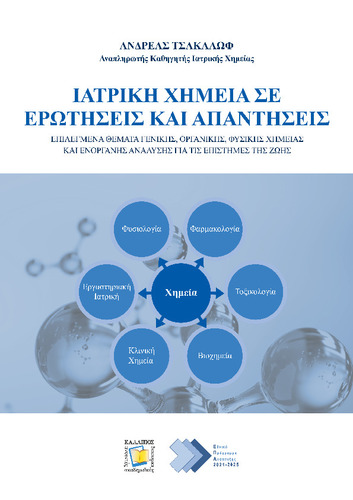| Title Details: | |
|
Medical Chemistry in questions and responses |
|
| Other Titles: |
Selected topics in General, Organic, Physical Chemistry and Instrumental analysis for life sciences |
| Authors: |
Tsakalof, Andreas |
| Reviewer: |
Simos, George |
| Subject: | MEDICINE AND HEALTH SCIENCES, LIFE SCIENCES, BIOLOGICAL SCIENCES > HEALTH SCIENCES > MEDICINE NATURAL SCIENCES AND AGRICULTURAL SCIENCES > PHYSICS > INDERDISCIPLINARY PHYSICS AND RELATED AREAS OF SCIENCE AND TECHNOLOGY > CHEMICAL THERMODYNAMICS NATURAL SCIENCES AND AGRICULTURAL SCIENCES > CHEMISTRY NATURAL SCIENCES AND AGRICULTURAL SCIENCES > CHEMISTRY > ANALYTICAL CHEMISTRY > CHEMICAL EQUILIBRIUM NATURAL SCIENCES AND AGRICULTURAL SCIENCES > CHEMISTRY > INORGANIC CHEMISTRY > COORDINATION COMPOUNDS NATURAL SCIENCES AND AGRICULTURAL SCIENCES > CHEMISTRY > ORGANIC CHEMISTRY NATURAL SCIENCES AND AGRICULTURAL SCIENCES > CHEMISTRY > CLINICAL CHEMISTRY > TOXICOLOGY (CHEMISTRY) NATURAL SCIENCES AND AGRICULTURAL SCIENCES > CHEMISTRY > PHYSICAL CHEMISTRY > CHEMICAL KINETICS |
| Keywords: |
Chemistry for Biomedical specialties
Physical Chemistry Bioorganic Chemistry |
| Description: | |
| Abstract: |
This textbook is the result of many years of teaching Medical Chemistry. Its main objective is the in-depth study of selected topics of General, Physical, Organic and Bio-organic Chemistry in order to form a solid chemical background, a general base of knowledge and concepts necessary, for the understanding and assimilation of the basics for medical and biomedical specialities courses in Biochemistry, Physiology, Pharmacology, Clinical Chemistry and Laboratory Medicine. This book offers an alternative approach to the study of the course material and to the creative learning through focused and specific questions as well as analytical responses, suggesting a specific study plan. In the sections of the textbook, a chemical background is first formed and then its value for the interpretation of biomedical phenomena and applications is demonstrated. For example, the periodic table is analyzed from a Medicine point of view, distinguishing the basic and trace elements of the human body, elements toxic to the human body (heavy metals). Similarly, the following suggestion concerning complex therapy and the treatment of mineral poisoning is based on the new, for students, knowledge of coordination compounds.
|
| Linguistic Editors: |
Kioseoglou, Nerina |
| Graphic Editors: |
Papakosmas, John |
| Type: |
Undergraduate textbook |
| Creation Date: | 26-08-2022 |
| Item Details: | |
| ISBN |
978-618-85820-7-1 |
| License: |
Attribution - NonCommercial - ShareAlike 4.0 International (CC BY-NC-SA 4.0) |
| DOI | http://dx.doi.org/10.57713/kallipos-54 |
| Handle | http://hdl.handle.net/11419/8447 |
| Bibliographic Reference: | Tsakalof, A. (2022). Medical Chemistry in questions and responses [Undergraduate textbook]. Kallipos, Open Academic Editions. https://dx.doi.org/10.57713/kallipos-54 |
| Language: |
Greek |
| Consists of: |
1. Periodic table - Features of Bioinorganic Chemistry - Toxicology 2. Chemical bond and non-covalent intermolecular interactions 3. Coordination compounds and chelation therapy 4. Acid-base equilibrium and blood pH regulation systems. Electrolytes and electrolytic behaviour of amino acids and drugs 5. Dispersion systems 6. Introduction to Organic Chemistry 7. Elements of the stereochemistry of organic compounds 8. Hydrocarbons - Aromatic hydrocarbons - Steroids 9. Simple oxygen, nitrogen and sulphur containing organic compounds 10. Carbonyl compounds: Aldehydes - Ketones 11. Elements of the chemistry of heterocyclic compounds 12. Chemical thermodynamics and chemical equilibrium 13. Chemical kinetics. Mechanisms of chemical reactions 14. Chromatography - Mass spectrometry 15. UV-Vis Spectroscopy - Spectrophotometry. Criteria for assessing the reliability of analytical methods and results |
| Number of pages |
232 |
| Publication Origin: |
Kallipos, Open Academic Editions |
| You can also view | |
| User comments | |
There are no published comments available! | |

